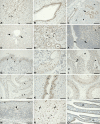Assessment of PARP-3 distribution in tissues of cynomolgous monkeys
- PMID: 19332431
- PMCID: PMC2699323
- DOI: 10.1369/jhc.2009.953380
Assessment of PARP-3 distribution in tissues of cynomolgous monkeys
Abstract
Poly(ADP-ribose) polymerase 3 (PARP-3) is a newly characterized PARP. In contrast to the two best-studied nuclear PARPs, PARP-1 and PARP-2, PARP-3 activity is apparently not stimulated by DNA damage. However, our previous work has demonstrated that PARP-3 interacts with several DNA damage response proteins, including Ku70/Ku80, DNA-PK, and PARP-1, suggesting that it contributes to the DNA damage response. Furthermore, a possible function for PARP-3 in the regulation of gene expression has been inferred from our observations that it associates with polycomb group proteins, which are responsible for epigenetic modifications leading to gene silencing. In this report, we extend our characterization of PARP-3 by revealing its distribution in the tissues and cell types of adult cynomolgous monkeys using a well-characterized PARP-3 polyclonal antibody. This study is the first to demonstrate that PARP-3 is genuinely expressed in most of the examined tissues. However, its expression is highly restricted to specific cell types of each tissue, indicating that PARP-3 expression is tightly regulated. One of the key findings of this study is that PARP-3 is highly expressed in the nuclei of epithelial cells forming the ducts of prostate, salivary glands, liver, and pancreas and in the neurons of terminal ganglia.
Figures



References
-
- Augustin A, Spenlehauer C, Dumond H, Menissier-De Murcia J, Piel M, Schmit AC, Apiou F, et al. (2003) PARP-3 localizes preferentially to the daughter centriole and interferes with the G1/S cell cycle progression. J Cell Sci 116:1551–1562 - PubMed
-
- Concha II, Figueroa J, Concha MI, Ueda K, Burzio LO (1989) Intracellular distribution of poly(ADP-ribose) synthetase in rat spermatogenic cells. Exp Cell Res 180:353–366 - PubMed
-
- Haince JF, Kozlov S, Dawson VL, Dawson TM, Hendzel MJ, Lavin MF, Poirier GG (2007) Ataxia telangiectasia mutated (ATM) signaling network is modulated by a novel poly(ADP-ribose)-dependent pathway in the early response to DNA-damaging agents. J Biol Chem 282:16441–16453 - PubMed
-
- Haince JF, McDonald D, Rodrigue A, Dery U, Masson JY, Hendzel MJ, Poirier GG (2008) PARP1-dependent kinetics of recruitment of MRE11 and NBS1 proteins to multiple DNA damage sites. J Biol Chem 283:1197–1208 - PubMed
-
- Hassa PO, Hottiger MO (2008) The diverse biological roles of mammalian PARPS, a small but powerful family of poly-ADP-ribose polymerases. Front Biosci 13:3046–3082 - PubMed
Publication types
MeSH terms
Substances
LinkOut - more resources
Full Text Sources
Research Materials
Miscellaneous

